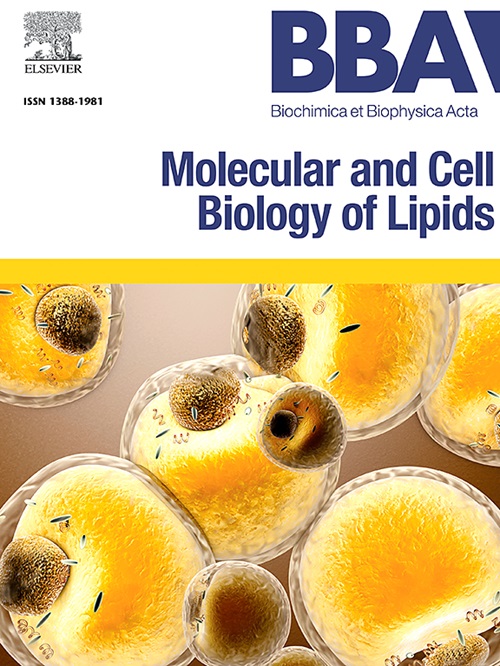Neurogenin 2-induced central neurons generated from NPC patient-derived iPSC display attenuated neurite outgrowth while accumulating cholesterol
IF 3.3
2区 生物学
Q2 BIOCHEMISTRY & MOLECULAR BIOLOGY
Biochimica et biophysica acta. Molecular and cell biology of lipids
Pub Date : 2025-05-26
DOI:10.1016/j.bbalip.2025.159639
引用次数: 0
Abstract
Niemann-Pick disease type C (NPC) is a lysosome disease hallmarked by autosomal recessive mutations in the NPC1 or NPC2 genes. It results in the accumulation of unesterified cholesterol in the late endosome/lysosome compartment, and then induces progressive neurodegeneration in affected individuals. Previous studies have primarily used fibroblasts derived from NPC patients to examine the cellular pathology and test therapeutic agents. However, the neurodegenerative aspect of the disease should be clarified using an in vitro system that recapitulates the cellular mechanisms underlying the neuronal defects. In this study, we generated iPSCs from NPC patients, and differentiated them into neurons to examine the pathological and biological defects in NPC neurons. Five iPSCs (3 NPC and 2 healthy individuals) carrying a doxycycline-inducible NGN2 (iPSCsTetON:NGN2) were generated, and edited cells efficiently differentiated into cortical neurons by 15 days. Although the standard differentiated culture method did not show any phenotypic features in NPC neurons, human-derived low-density lipoprotein (LDL) treatment exhibited cellular pathological features, including the accumulation of unesterified cholesterol and impaired neurite outgrowth. Miglustat, a drug approved for NPC in several countries, promoted neurite outgrowth and reduced unesterified cholesterol accumulation in LDL-treated NPC neurons. Using our model, two drugs among an FDA-approved drug library attenuated the pathological defects by LDL treatment. Collectively, our results indicate that neurons of NPC patients fail neurite extension due to suboptimal cholesterol transport to the membrane. This will be a valuable tool for NPC research to identify the pathological mechanisms of neuronal degeneration and to discover new therapeutics.
ipsc建立的鼻咽癌患者的神经原素2诱导的中枢神经元在积累胆固醇的同时显示神经突生长减弱。
尼曼-匹克病C型(NPC)是一种溶酶体疾病,其特征是NPC1或NPC2基因常染色体隐性突变。它导致未酯化胆固醇在晚期内核/溶酶体间室的积累,然后在受影响的个体中诱导进行性神经变性。以前的研究主要是使用来自鼻咽癌患者的成纤维细胞来检查细胞病理学和测试治疗药物。然而,该疾病的神经退行性方面应该使用体外系统来阐明,该系统概括了神经元缺陷背后的细胞机制。本研究从鼻咽癌患者中提取iPSCs,并将其分化为神经元,以检测鼻咽癌神经元的病理和生物学缺陷。5个iPSCs(3个NPC和2个健康个体)携带强力环素诱导的NGN2 (iPSCsTetON:NGN2),编辑后的细胞在15 天内有效分化为皮质神经元。尽管标准分化培养方法未显示鼻咽癌神经元的任何表型特征,但人源性低密度脂蛋白(LDL)处理显示出细胞病理特征,包括未酯化胆固醇的积累和神经突生长受损。米卢司他(Miglustat)是一种在多个国家批准用于鼻咽癌的药物,可促进神经突生长并减少ldl处理的鼻咽癌神经元的未酯化胆固醇积累。使用我们的模型,fda批准的药物库中的两种药物通过LDL治疗减轻了病理缺陷。总的来说,我们的结果表明,鼻咽癌患者的神经元由于不理想的胆固醇转运到膜而导致神经突延伸失败。这将为NPC研究确定神经元变性的病理机制和发现新的治疗方法提供有价值的工具。
本文章由计算机程序翻译,如有差异,请以英文原文为准。
求助全文
约1分钟内获得全文
求助全文
来源期刊
CiteScore
11.00
自引率
2.10%
发文量
109
审稿时长
53 days
期刊介绍:
BBA Molecular and Cell Biology of Lipids publishes papers on original research dealing with novel aspects of molecular genetics related to the lipidome, the biosynthesis of lipids, the role of lipids in cells and whole organisms, the regulation of lipid metabolism and function, and lipidomics in all organisms. Manuscripts should significantly advance the understanding of the molecular mechanisms underlying biological processes in which lipids are involved. Papers detailing novel methodology must report significant biochemical, molecular, or functional insight in the area of lipids.

 求助内容:
求助内容: 应助结果提醒方式:
应助结果提醒方式:


